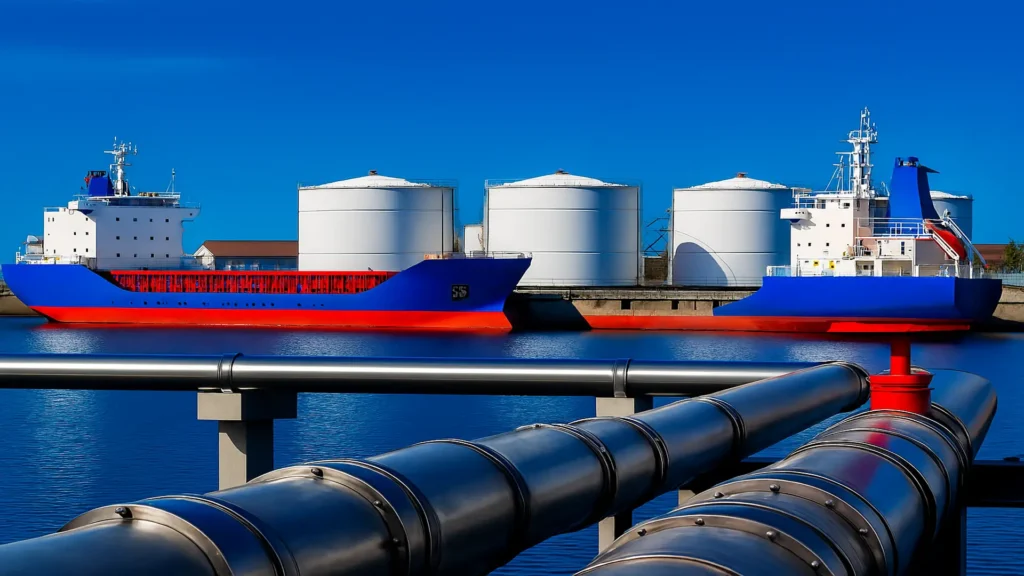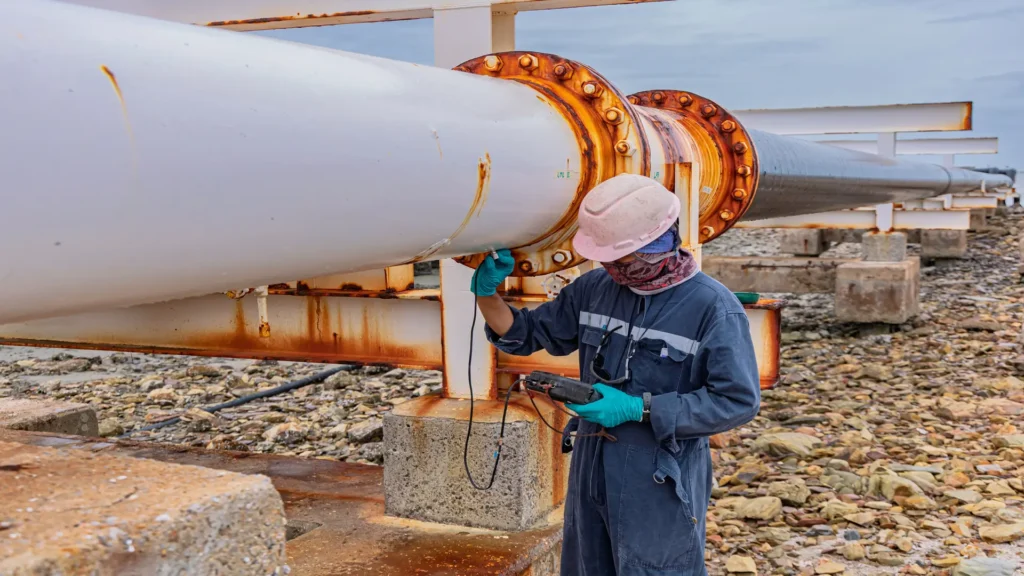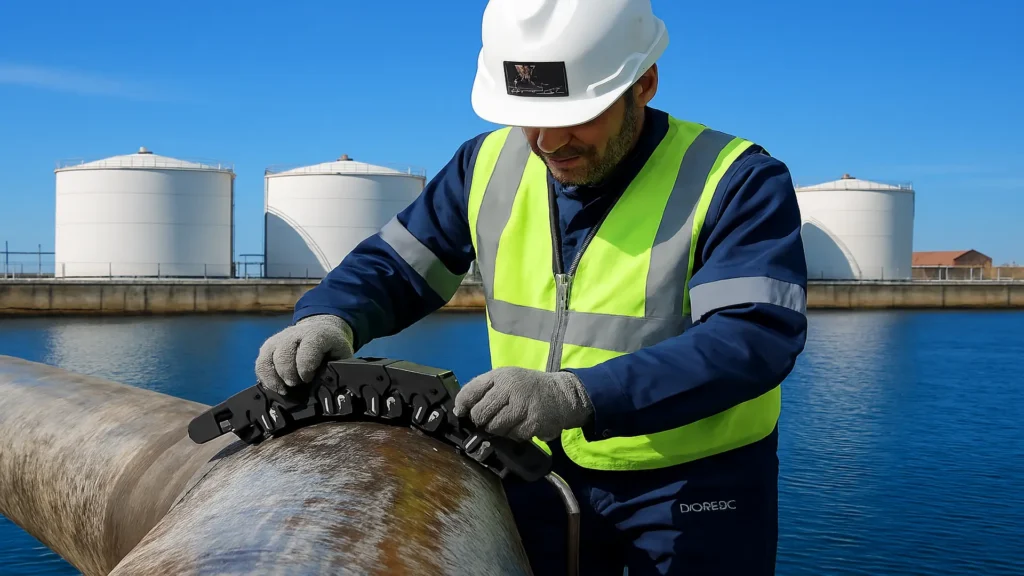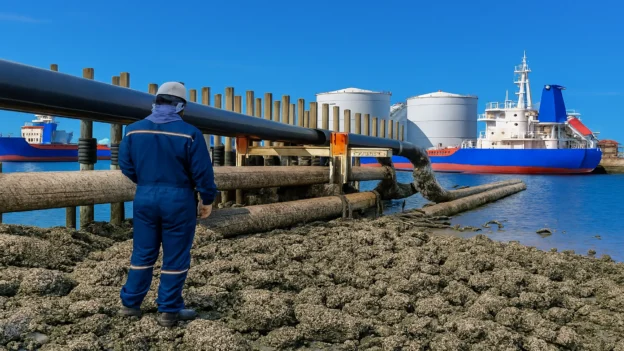Pipeline inspections at light product terminals are a fundamental pillar for ensuring the structural and operational integrity of hydrocarbon transportation systems. These specialized processes go beyond simply identifying faults, allowing professionals to obtain critical data on the internal condition of pipeline networks and establish predictive maintenance strategies that optimize asset life.
The light product terminal industry faces unique challenges due to the nature of the fluids transported and extreme operating conditions. Pipelines that handle gasoline, diesel, jet fuel, and other petroleum products are exposed to specific degradation factors that require highly specialized inspection methodologies and rigorous evaluation protocols.
Pipeline inspection in Gas & Oil marine terminals
Pipeline inspection in light product terminals pursues multidimensional objectives that transcend basic defect detection. Systematic analysis of the interior of the networks allows for the establishment of structural integrity baselines, the identification of degradation patterns specific to the product being transported, and the development of predictive failure models based on historical performance data.
The collection of information during inspections facilitates strategic planning for future interventions, optimizing maintenance resources and minimizing operational downtime.

Cutting-edge inspection technologies
Pipeline integrity at light product terminals is critical to ensuring operational safety, supply reliability, and regulatory compliance. With technological advances, inspection techniques have evolved toward more accurate, digital, and predictive methods.
The selection of the appropriate technology depends on the type of pipeline, the criticality of the line, and the operating conditions. In light product terminals, trends point toward a hybrid approach, combining traditional advanced inspection methods (UTPA, EC) with digital tools (drones, IoT sensors, and online monitoring). This allows not only for the detection of existing faults, but also for the anticipation of future behavior through predictive maintenance.
The integration of artificial intelligence and machine learning algorithms has transformed the analytical capabilities of pipeline inspections. These advanced systems process massive volumes of data from multiple sources, including distributed sensor readings, historical maintenance records, and operational performance data, identifying subtle patterns that could indicate the development of incipient anomalies.
Machine learning algorithms can detect early indicators of emerging problems, such as cavitation in pumps, microscopic leaks in valves, or variations in flow parameters that precede major failures. Applying this predictive capability enables the implementation of proactive maintenance strategies that prevent operational disruptions and significantly reduce the costs associated with emergency repairs.
Ensayos No Destructivos especializados
Ultrasonido Industrial (UT)
Las pruebas ultrasónicas representan una de las metodologías más precisas para la detección de defectos internos en tuberías de productos ligeros. Esta técnica utiliza ondas sonoras de alta frecuencia para penetrar el material e identificar discontinuidades, variaciones de espesor y zonas de corrosión localizada con resolución sub-milimétrica.
La implementación de arreglos de transductores ultrasónicos permite realizar mapeos tridimensionales de la condición interna de las tuberías, generando representaciones gráficas detalladas que facilitan la interpretación de resultados y la toma de decisiones de mantenimiento. Los sistemas automatizados de UT pueden procesar kilómetros de tubería en tiempos reducidos, manteniendo estándares de precisión consistentes, tambien son muy utilizados para medir el espesor de un material.

Magnetic Flux Leakage (MFL)
Magnetic flux leakage technology has proven particularly effective in detecting metal loss due to internal and external corrosion in ferromagnetic pipes. High-resolution MFL systems can identify defects with depths of 10% of the nominal wall thickness, providing quantitative information on the severity and extent of the detected anomalies.
Modern MFL equipment incorporates multiple sensors distributed circumferentially, allowing for the complete characterization of complex defects and the generation of detailed corrosion maps.
Pulsed Eddy Currents (PEC)
Pulsed eddy current techniques offer unique capabilities for inspecting pipelines with multiple coatings and cathodic protection systems. This methodology can penetrate layers of insulation and detect corrosion under coatings, a significant challenge in light product terminals where pipelines are often protected by complex coating systems.
PEC technology provides information on both surface and subsurface defects, enabling a comprehensive assessment of pipeline condition without the need to remove protective coatings.

Below is a comparative table showing the most prominent technologies used in the industry.
Comparative Table of Pipeline Inspection Technologies
| Technology | Operating Principle | Technical Advantages | Limitations | Applications in Light Product Terminals |
|---|---|---|---|---|
| Advanced Ultrasonics (UTPA/TOFD) | Emission of ultrasonic waves that detect thickness variations and internal defects. | High accuracy in thickness measurement, detection of localized corrosion and cracks. Allows digital recording. | Requires surface cleaning and proper coupling. Limited in complex geometries. | Inspection of critical discharge and transfer lines. Monitoring of corrosion under insulation (CUI). |
| Acoustic Emission (AE) | Detection of waves generated by energy release in active defects (cracks, leaks, active corrosion). | Enables in-line inspection, global coverage over long sections, real-time activity detection. | Does not quantify the exact size of damage, requires correlation with other techniques. | Early identification of leaks and cracks in transfer pipelines to tanks. |
| Digital Radiography / Computed Tomography (DR/CT) | Use of ionizing radiation and digital detectors to generate high-resolution images. | Detailed inspection of welds, detection of inclusions, lack of fusion, and internal corrosion. Digitalization facilitates traceability. | Requires strict radiological control and safety zones. High costs. | Evaluation of critical welds in loading/unloading lines. |
| Advanced Eddy Currents (EC/PEC) | Generation of electromagnetic fields that interact with the material, detecting changes in conductivity and thickness. | Very useful in pipelines with coating or insulation. Allows corrosion detection without removing the coating. | Limited to conductive materials, complex interpretation in irregular geometries. | Detection of corrosion under coatings in buried or insulated lines. |
| Drone and Robotic Inspection | Use of aerial drones and crawlers equipped with HD cameras, UT/EC sensors, and LIDAR. | Reduces human risk, accesses confined areas, generates 3D models of pipelines and racks. Fast and safe inspection. | Dependent on weather conditions and battery autonomy. Requires data validation. | Visual and dimensional inspection in pipe racks, detection of surface leaks. |
| Inline Sensing (Fiber Optic Sensing / IoT) | Fiber optics or IoT sensors installed along the pipeline to detect vibrations, temperature, and leaks. | Continuous monitoring, high sensitivity, integration with SCADA systems. Immediate anomaly detection. | Requires high initial investment and communication infrastructure. | Real-time supervision of critical transfer lines and marine loading. |
Prevention and mitigation strategies
Corrosion protection systems
The implementation of integrated cathodic protection systems is a fundamental strategy for preventing corrosion in light product terminal pipelines. These systems must be designed taking into account the specific characteristics of the product being transported, local environmental conditions, and the electrochemical properties of the surrounding soil. Specialized coatings, in combination with chemical inhibitors, provide multiple protective barriers against corrosion mechanisms.
Advanced predictive maintenance
Condition-based predictive maintenance uses real-time data to optimize maintenance interventions and maximize operational availability. Continuous monitoring systems can detect gradual changes in critical parameters such as pressure, temperature, vibration, and chemical composition, providing early warnings of abnormal conditions.
Smart sensors are integrated throughout the pipeline network, enabling continuous monitoring of critical parameters and automatic detection of deviations from normal operating conditions.
Quantitative assessment systems
Modern risk management systems incorporate quantitative methodologies to assess the probability of failure and the potential consequences associated with different modes of degradation.
A combination of multiple sensor technologies on robotic platforms allows for the simultaneous acquisition of ultrasonic, magnetic, and visual data, providing multidimensional characterizations of pipeline condition. The implementation of dynamic risk matrices allows inspection and maintenance activities to be prioritized based on objective technical criteria and cost-benefit considerations.
Comprehensive risk management
Investing in quantitative risk management systems, predictive maintenance protocols, and specialized training for technical personnel not only complies with regulatory requirements but also generates significant economic value by optimizing maintenance costs and minimizing operational disruptions at terminals.
All the experience gained from historical accidents has unequivocally demonstrated that systematic inspection programs, supported by highly trained personnel and state-of-the-art technologies, are the most effective strategy for preventing catastrophic failures and ensuring operational continuity.
Emergency response protocols
The development of specialized emergency response protocols must consider the specific risks associated with different types of light products. When contingency plans are previewed, they must include detailed procedures for the rapid isolation of affected sections, spill containment, and coordination with specialized response teams.
In order to ensure operational preparedness and training, it is essential that regular staff training in these protocols be combined with planned drills to respond effectively to emergency situations and minimize the consequences of unwanted events.
Artificial Intelligence in Inspections
The application of artificial intelligence algorithms is transforming the capabilities of pipeline inspection analysis. Deep learning systems can process visual inspection images, non-destructive testing data, and operational parameters to identify complex patterns that might escape traditional human analysis.
These technologies enable the automatic detection of incipient anomalies, the automated classification of defects according to their severity, and the prediction of the real-time evolution of identified deterioration. The implementation of these systems reduces variability in the interpretation of results and improves the robustness of maintenance decisions.
Robotics for navigating through pipes
The possibilities for inspection in highly complex and risky environments are expanding thanks to specialized robotic systems. Internal inspection robots can travel long distances, making it possible to conduct a fantastic journey through pipes in service, collecting detailed data on internal conditions without interrupting normal operations. The integration of emerging technologies such as artificial intelligence, machine learning, and specialized robotics is redefining inspection capabilities, providing previously unattainable levels of accuracy and efficiency.
Application of regulations and standards
Pipeline inspections at light product terminals must comply with rigorous international standards that establish minimum requirements for inspection frequencies, testing methodologies, and acceptance criteria. Compliance with these regulations not only ensures regulatory compliance but also establishes the technical basis for safe and sustainable operations.
For different types of light products, specific standards recognize the particular characteristics of each fluid and establish inspection protocols tailored to the predominant degradation mechanisms. API 570 applies to piping systems that use process fluids, hydrocarbons, chemicals, natural gas, high-pressure gases, and other flammable or toxic fluids, and ASME B31.3, which establishes requirements for industrial piping systems.
Traceability from planning to corrective actions
Establishing reliable technical records to support integrity management decisions is essential, and this requires having all the documentation from the countless inspection activities carried out. Digital data management systems allow the integration of results from multiple inspection techniques, facilitating comparative analysis and the identification of temporal trends.
From initial planning to the implementation of corrective actions, complete traceability of inspection processes provides objective evidence of compliance with technical standards.
Conclusions
The implementation of advanced inspection methodologies in light product terminal pipelines represents a fundamental strategic investment for operational sustainability and effective risk management in the hydrocarbon industry. This technological evolution has provided sophisticated tools that enable early detection of anomalies and accurate characterization of degradation mechanisms, facilitating the transition to predictive maintenance models based on actual conditions.
A combination of technological advances and proven traditional methodologies such as ultrasonic testing, magnetic flux leakage, and pulsed eddy currents create comprehensive inspection ecosystems that maximize the reliability of results and optimize technical decision-making. The future of pipeline inspections is moving toward intelligent automation, continuous real-time monitoring, and the integration of multiple remote monitoring technologies.

